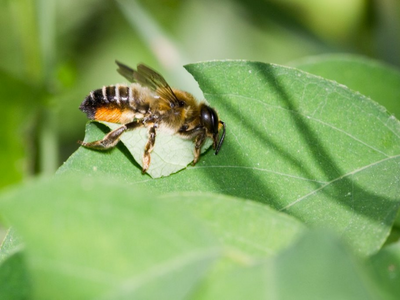There are more than 250 species of bee in the UK. Bumblebees, Mason Bee’s and Mining Bees are just one small part of a big, BEE-UTIFUL family.
Bumblebee
There are a number of bumblebees including the red-tailed, white-tailed, small garden and early bumble bees. They are loud, fluffy bees that look utterly strokeable which are generally black with varying degrees of yellow banding. They measure up to 22mm long, depending on the species and whether it’s a queen, male or worker.
You will see bumblebees throughout the garden, collecting pollen and nectar from a variety of flowers and blossoms.
FUN FACT:
Bumblebees have the longest tongue of all UK bees reaching over just 2cm at full stretch.

Honey Bee’s
Honeybees are slim and they have a striped golden body and they are more common than bumblebees. They are approx. 1.2cm in size and you will see them from March to September.
They make honey from pollen and nectar collected from flowers such as lavender, fruit blossom and oilseed rape.
They live in large colonies with one queen, many sterile female workers and some male drones. A signal bee hive may contain as many as 50,000 individuals.
FUN FACT:
Honeybees are brilliant boogiers! To share information about the best food sources they perform their waggle dance. When the worker returns to the hive, it moves in a figure of eight and waggles its body to indicate the direction of the food source.

Common carder bees
Carders are all brown bees ranging from light orange to a yellow brown. They are found in most gardens and enjoy taking nectar from weeds such as dandelions and dead nettles. They are approx. 1.3 cm in size and will be seen from March to November.
They nest in cavities such as old mouse runs, in bird’s nests or in moss mats in lawns.

Mason bees
Mason bees live in the brickwork of houses, wood, hard dead flower stalks and walls. They have quite black faces with a deep ginger body and a squarer head than other bees.
They collect building material such as mud to construct a small home in masonry study gaps. They are seen from April to March and are common throughout much of the UK.

Mining bees
Mining bees are the bees that leave little piles of earth on your lawn, these miniature volcanoes are the work of mining bees that nest in the ground. There are many different species such as ashy mining bee and they range from dark fluffy orange to pale fluffy yellow.
The Tawny mining bee is on the wing from April to June, which coincides with the flowering of fruit trees like cherry, pear and apple. The female collects pollen and nectar for the larvae which develop underground and hibernate as pupa over winter.

Leaf cutting bees
There are seven species of leaf-cutting bees in Britain. They have a wingspan of 8-14mm and are dark brown bees covered in lighter brown or orange hairs.
You will see leaf cutting bees from April to August and they nest in holes in plant stems, dead wood, cliffs or old walls and can be seen in gardens. They feed on pollen and nectar. They famously cut discs out of leaves, creating a nest by gluing them together with saliva.

Why are bees so important?
While, to many they are simply the fuzzy flying insects we see darting among the flowers during the warmer months, bees are actually so much more than this and have an important part to play in maintaining our planet. Where trees and woods are essential to filter our air, bees are vital to both pollinate the food we need to survive and pollinate many of the trees and flowers that provide habitats for wildlife.
While there are other methods of pollination, including by wind, birds, bats and other insects, wild bees are among the most important because they are capable of pollinating on a much bigger scale. It has been estimated that it would cost farmers in the UK an incredible £1.8 billion per year to manually pollinate their crops which emphasises the importance of all difference species of bees within the UK.
